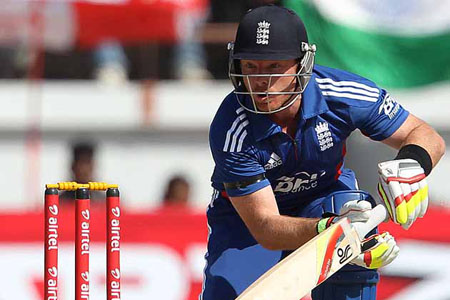
Rajkot: Indian batsmen and bowlers failed in unison as they suffered yet another defeat, this time against England, in the first of the five ODIs here on Friday. First the bowlers leaked 325 runs, with Ishant Sharma going for none for 86 in his ten overs, then the batsmen couldn't keep up with the required rate as England closed the contest with a nine-run victory, their first on Indian soil in an ODI since 2006.
As it happens so often in big chases that pendulum swings from one side to the other with the team defending the total holding the edge, England had their nose in front for the most part of the Indian innings. Although India got off to a breezy start, with Ajinkya Rahane and Gautam Gambhir sharing 96 runs for the opening wicket, England came back strongly with three quick wickets.
Rahane was the first to go when he chipped Tredwell to Jade Dernback at long-off. Gambhir didn't last long too as he got out, flicking straight to Ian Bell at short midwicket off Tredwell, after completing his fifty. Virat Kohli's woeful form continued as he once again departed cheaply, giving a simple catch to Craig Kieswetter behind the wickets off Tim Bresnan.
Yuvraj Singh (61) and Suresh Raina (50), in their stand of 60 for the fourth wicket, tried to take the game away from England but Tredwell once again came to the visitors' rescue, getting the prized wicket of Yuvraj, who played some impeccable pull shots during his knock.
Raina took the charge after the fall of Yuvraj as the left-hander smacked a few audacious strokes to keep the pressure off skipper MS Dhoni. But his wicket, which was once again taken by Tredwell, forced Dhoni to take more risk. The Indian skipper did hit four sixes during his 32-run knock, his wicket, taken by Dernbach with a slower delivery, almost sealed the match for England. Ravindra Jadeja, playing on his home ground, too fell in the same over, edging one to the stumps for just nine runs.
Tredwell was the most successful of the English bowlers, picking up 4 for 44, while Dernbach and Tim Bresnan shared two wickets apiece and Steven Finn got one.
It was as good a wicket a batsman could have hoped to bat on and the England batsmen did not miss a chance to make the most of it, setting a mammoth 326 for India to chase. Bell was the top scorer for England with his 96-ball 85, while Alastair Cook (75), Kevin Pieteren (44) and Eoin Morgan (41) too played crucial knocks to take the score past 300.
The Indian bowlers tried their best to restrain the England scoring but all of them went for plenty as the wicket at the newly-constructed Saurashtra Cricket Association offered nothing to help their cause. Apart from Ishant, who had dreadful day, other Indian bowlers too were taken to the cleaners.
Bell and Cook gave England the perfect start, stringing 158 after the visitors won the toss and decided to bat. The duo treated the Indian bowlers with utter disdain, punishing anything that could have fetched runs. Bell, in particular, was in fluent touch, cutting and pulling the pacers while sweeping and lofting the spinners for big shots. The positive mindset of Bell rubbed off on Cook as the England captain took full toll of anything that was pitched full to him.
Bell got to his half-century when he reverse-swept Jadeja for a boundary, while Cook got the landmark with a single off a conventional sweep. Both departed in quick succession, with Bell getting run out to a direct throw by Rahane, while Cook too found Rahane at short fine when he tried to sweep Raina.
But Pietersen and Morgan got in the groove quickly as the duo accumulated 44 runs in the batting powerplay. But when it looked the two would propel England to a mammoth total, Ashok Dinda struck twice. He caught Morgan in his follow-through, while got Pietersen caught at long-off where Kohli leaped forward to take a good diving catch.
Samit Patel (44*) and wicketkeeper batsman Kieswetter (24*) played useful cameos to take England to 325. Both added 70 in just 37 deliveries, including 64 in the last five overs.





Comments
Add new comment